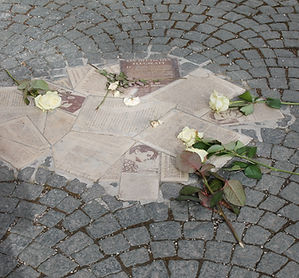
Source: Jaya Mirani
Jesse and Leo
Memories
of Nazism in Munich's Streets
The Dichotomy of Memorials to Victims and Resisters
Memorials are a significant expression of collective public memory and values. In this virtual city tour, we ask questions about what can be learned from two types of memorials in Munich’s streets relating to the Nazi era, the ones dedicated to victims of National Socialism and the ones commemorating specific acts of resistance against the regime.
The process of commemorating both victims and resisters is ongoing in Germany to this day. Munich, the city that witnessed the birth of the Nazi movement, has attempted to come to terms with its past in various ways, one of which is public memorialization.
During this virtual tour, we will show you the memorials dedicated to the White Rose resistance group, the Viscardigasse memorial about silent defiance of Munich’s citizens to the Nazis, and several memorials to the persecuted including the Square for the Victims of National Socialism, the Stumbling Stones, and the Path of Memory. As we discuss the history and development of these sites and their symbolism, some of the struggles associated with the memory of the Nazi period will become apparent. Although we do not promise all the answers, we hope you will come away with a deeper understanding of the complexity of collective memory and public commemoration in Munich.
“It is not up to us to pass final judgment regarding the meaning of our history. But if this catastrophe shall be our sure salvation, then it shall be so: We will be cleansed by suffering, we will long for the light from the midst of the blackest night, we will summon our energy and finally help shake off the yoke that oppresses the world….
Three hundred thousand Jews have been murdered in that country [Poland] in the most bestial manner imaginable. In this we see a terrible crime against the dignity of mankind, a crime that cannot be compared with any other in the history of mankind…. Hardly anyone even gives them a second thought. The facts are accepted as just that and filed away.”
Excerpts from the Second Leaflet of the White Rose, Summer 1942
Group Members
Jesse Corey and Leopold Grünwald
Video produced with Jaya Mirani
Credits for the images used in the video
Google Earth (30 June 2021). Munich, Germany.
Odensplatz Photos: Stadtarchiv München
White Rose Photo by George Jürgen Wittenstein, Public Domain.
Elser Memorial: Public domain (Wikipedia)
Sources
Bernstein, Martin (24 November 2015). “Stolpersteine landen vor Gericht.” Süddeutsche Zeitung.
Buruma, Ian (1994). The Wages of Guilt: Memories of War in Germany and Japan. London: Atlantic Books.
“Der lange Weg zum neuen Zentrum” (8 November 2011). Bayerischer Rundfunk.
Memminger, Josef (3 March 2016). “Good or bad remembrance? No Stolpersteine in Munich.” Public History Weekly.
“Munich Introduces New Holocaust Remembrance Plaques” (29 July 2018). Times of Israel.
“New Jewish Museum Opens in Munich” (22 March 2007). DW.
Rosenfeld, Gavriel (2000). Munich and Memory: Architecture, Monuments, and the Legacy of the Third Reich. Berkeley: University of California Press.
Links and Addresses to the memorials
DenkStätte Weiße Rose
LMU Munich
Geschwister-Scholl-Platz 1
D-80539 Munich
DenkStätte Weiße Rose on the homepage of the City of Munich
Jewish Community of Munich and Upper Bavaria
Kurt Eisner Memorial at:
Kardinal-Faulhaber-Straße 14
D-80333 Munich
LGBT Memorial at Corner of Dultstraße and Oberanger, 80331 Munich
Platz der Opfer des Nationalsozialismus
80333 Munich
Official Homepage of the “Stolpersteine”-Project
Wank, Bruno. “Argumente 1995”
Viscardigasse
80333 Munich